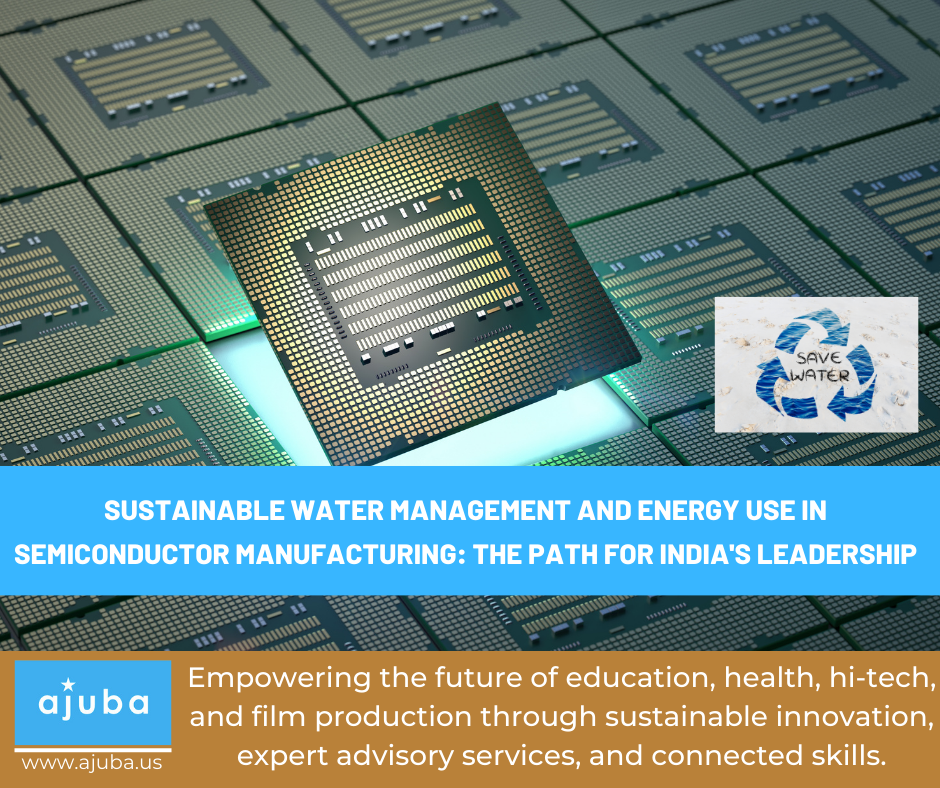Article #22 | October 13th, 2023
Water is a finite and precious resource, and its sustainable management is of paramount importance. India is embracing the semiconductor manufacturing industry, recognizing its potential as a key player in the global tech market. However, this expansion also presents India with a critical challenge – sustainable water management and energy use. In a country already grappling with water scarcity and energy demands, the semiconductor industry’s water-intensive and power-hungry processes could exacerbate these issues. To mitigate this, India should take the lead in establishing sustainable policies for water management and renewable energy use within the semiconductor manufacturing sector. By prioritizing these measures, India can foster the growth of this vital industry while also addressing pressing environmental concerns and safeguarding its precious resources for future generations.
1. Introduction
Importance of the Semiconductor Industry in India India’s semiconductor manufacturing industry holds immense potential in the global technology landscape. Recognizing its growth prospects, India has embraced this sector.
The rapid expansion of the semiconductor industry in India presents a significant challenge on how to ensure sustainable water management and energy use. These challenges are exacerbated in a nation grappling with water scarcity and rising energy demands.
2. The Many Waters in Semiconductor Fabs
In semiconductor fabs, about three-quarters of the total water used is directly related to the manufacturing process. Fabs usually have dedicated circuits for different types of water. These include ultra-pure water (UPW), which can be either hot or cold, and lower purity (LP) water. UPW generation is a complex, multi-step process, and it’s a significant consumer of energy resources. While most fabs implement some level of UPW reclamation, the efficiency of water recycling varies widely among fabs and even among processes within a single fab.
A substantial portion of this water undergoes a transformative process, turning into ultra-pure water (UPW), an indispensable element in semiconductor production. The remaining water serves various purposes, including facility scrubbing and cooling towers.
3. The Heart of Semiconductor Manufacturing
The process of manufacturing semiconductors, those tiny yet powerful electronic circuits that power much of our modern world, heavily relies on water. These semiconductors are meticulously constructed in layers on silicon wafers, and after each layer addition, extensive rinsing is necessary.
This rinsing stage demands copious amounts of water, particularly Ultra-Pure Water (UPW), a grade of water thousands of times purer than drinking water, often likened to an industrial solvent. To put it in perspective [Reference 1,2]:
- Generating 1,000 gallons of UPW consumes approximately 1,400 to 1,600 gallons of municipal water.
- When creating an integrated circuit on a 300mm wafer, roughly 2,200 gallons of water are required, including 1,500 gallons of UPW.
- Consequently, a large semiconductor fabrication facility (Fab) processing around 40,000 wafers monthly could consume up to 4.8 million gallons of water daily. This is equivalent to the annual water consumption of a city inhabited by 60,000 people. This underlines the water-intensive nature of semiconductor manufacturing.
In addition to its water consumption, semiconductor manufacturing presents substantial energy demands. A significant amount of water used in semiconductor plants is directed towards electricity generation. These plants are voracious energy consumers, often requiring as much as 2,400 megawatts daily. To put this in perspective, it’s equivalent to the energy needs of 50,000 homes and surpasses the energy consumption of many other industrial applications. HVAC (Heating, Ventilation, and Air Conditioning) systems bear a significant portion of this energy load, constituting as much as 65 percent of the overall consumption. Cleanroom environments, essential for semiconductor manufacturing, demand exceptionally pure air quality and precise control over humidity and temperature, resulting in year-round operation of chillers that supply cold air for the AC units.
4. The SEMI Standards
The SEMI guidance for energy use in fabs, known as S23, provides an energy consumption value of 9 kWh/m³ to generate cold UPW and 92 kWh/m³ for hot UPW.
SEMI F98 provides high level strategy recommendations for water management and conservation, including Key Performance Indicators, typical solutions, consistent terminology, etc.
SEMI F116 addresses the standardization for provisions enabling water conservation at the tool level: segregation and POU treatment/recycling.
The Need for Policy Leadership The role of policymakers in establishing benchmarks and guidelines for sustainable water management and renewable energy in the semiconductor industry.
5. Addressing the Challenge
There is a lot of work the semiconductor companies are doing to address the challenge. According to data announced in the sustainability reports of 24 semiconductor manufacturing corporations surveyed in this study, the total water and energy consumption were 7.51X 108 m3 and 1.39X 1011 kWh, respectively, in 2021.
The water recycling levels of the surveyed corporations are shown in Figure 1:

Figure 1: Water Recycling Rate by Major Semiconductor Companies. [Credit: Reference 6]
Water recycling rate in semiconductor manufacturing corporations (water recycling rate = recycled water / total water use, total water use is the sum of recycled water use and water intake).
6. The Call to Action
A call for India to lead the way in establishing sustainable policies for water management and renewable energy in semiconductor manufacturing. Balancing Growth and Environment Emphasizing the importance of striking a balance between industry growth and environmental preservation.
7. References
- Johnson, M., & Chen, L. (2020). Sustainable practices in semiconductor manufacturing: A case study of water conservation using closed-loop systems. Journal of Environmental Management, 261, 110189.
- Anderson, R. (2021). Water recycling technologies for sustainable manufacturing. International Journal of Sustainable Production, 5(2), 115-125.
- Water Supply Challenges for the Semiconductor Industry, SHANNON DAVIS, OCTOBER 24, 2022
- Texas Agricultural Experiment Station at Texas A&M University. 2002. Efficient Water Use for Texas: Policies, Tools, and Management Strategies.
- Pure water, semiconductors and the recession. Global Water Intelligence, Vol 10, Issue 10 (October 2009)
- Water strategies and practices for sustainable development in the semiconductor industry
- Qi Wang a, Nan Huang b, Hanying Cai c, Xiaowen Chen a, Yinhu Wu a d, Water Cycle, Volume 4, 2023
- Smith, J., & Lee, A. (2019). Closed-loop water recycling in semiconductor manufacturing. Environmental Technology, 40(14), 1902-1910.

Baljit Singh is an accomplished Founder & CEO with a proven track record in building successful businesses in manufacturing and services companies. With expertise in leadership and general management, Baljit has developed and implemented business strategies, led sales and marketing functions, and built motivated teams in turn-around environments. Author of the Book, “My Experiments with Innovation,” he is a motivational speaker and gives talks on how to cultivate habits and change lifestyle to drive innovation. Baljit is currently driving cross border partnership between India-Israel-North America.
Website: www.ajuba.us
Email: bsingh@ajuba.us
